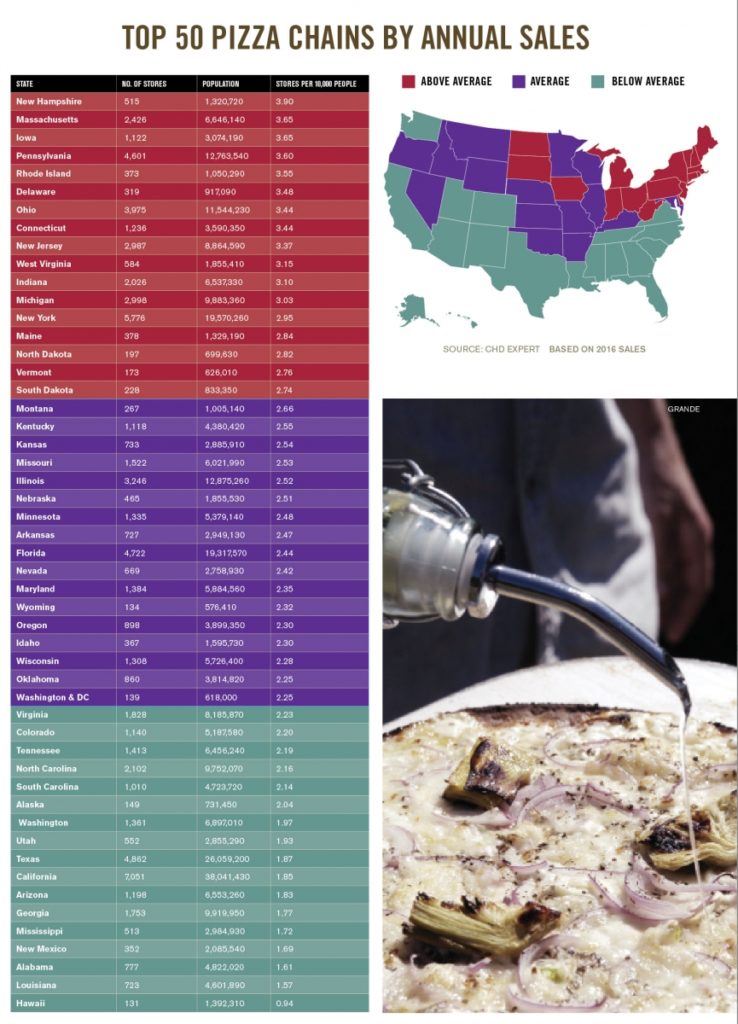Pizza makes everything better, but the world’s greatest food had to work overtime in 2016, which will long be remembered as the year we’d rather forget. Atrocities, natural disasters, the Syrian refugee crisis and the nastiest presidential election in recent memory left us all crying out for comfort—and pizza, as always, was there for us, dripping gooey, melty cheese and salty, savory goodness over our woes and worries.
So it should come as a surprise to no one that pizza consumption this year climbed to its highest level in the past four years, according to research firm Technomic’s 2016 Pizza Consumer Trend Report. Forty-one percent of consumers polled say they now eat pizza once a week, a big jump from 26% just two years ago. And a Harris Poll found pizza is Americans’ No. 1 favorite comfort food, earning twice as many votes as any other dish. (Take that, chocolate!)
In other words, don’t let anyone tell you that you’re in the wrong business. The pizza industry, in fact, forged ahead in the past year, even though independents, bound to decades of proud tradition and slow to adopt new technologies, continued to lag behind the chains in market share. All in all, the signs point to modest growth in the segment, with fast-casual chains leading the charge and online ordering technology and third-party delivery options fueling the engine. Now let’s take a deeper look.
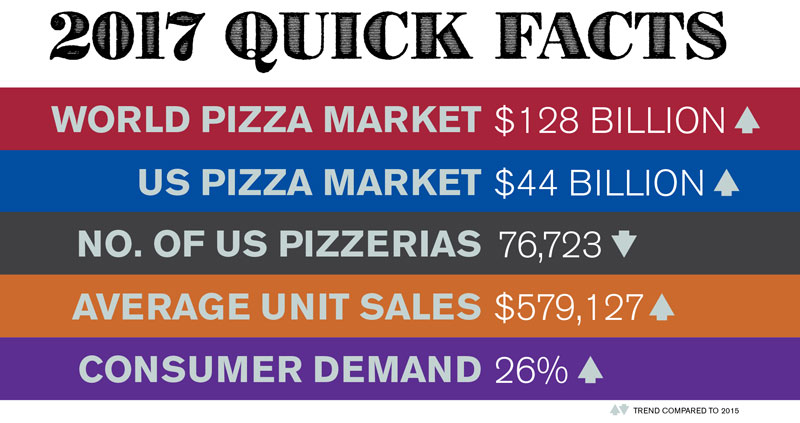
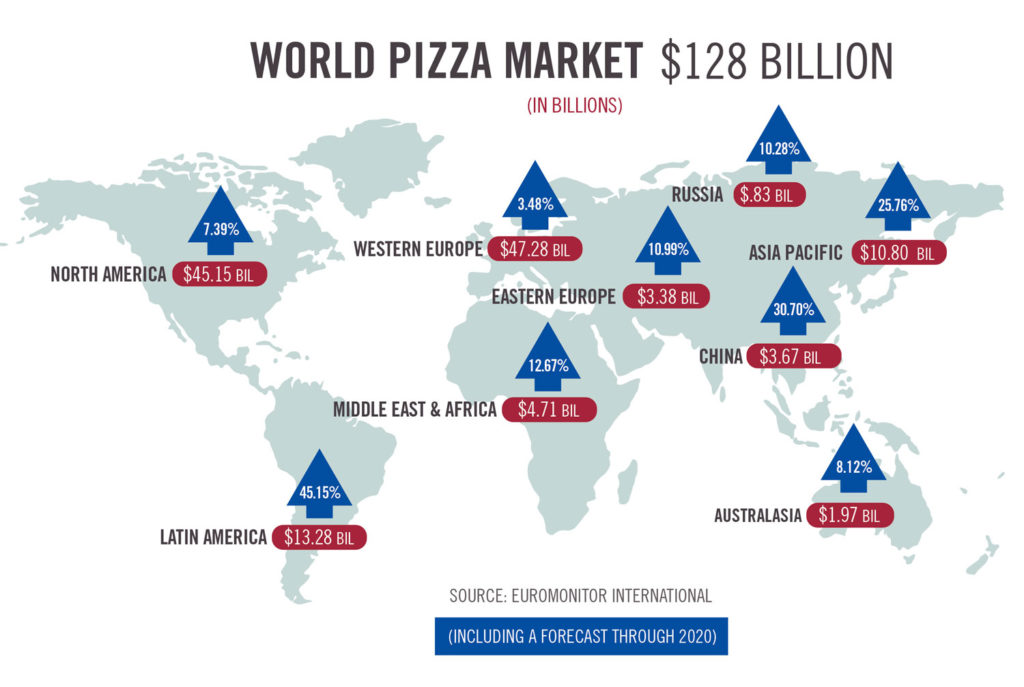
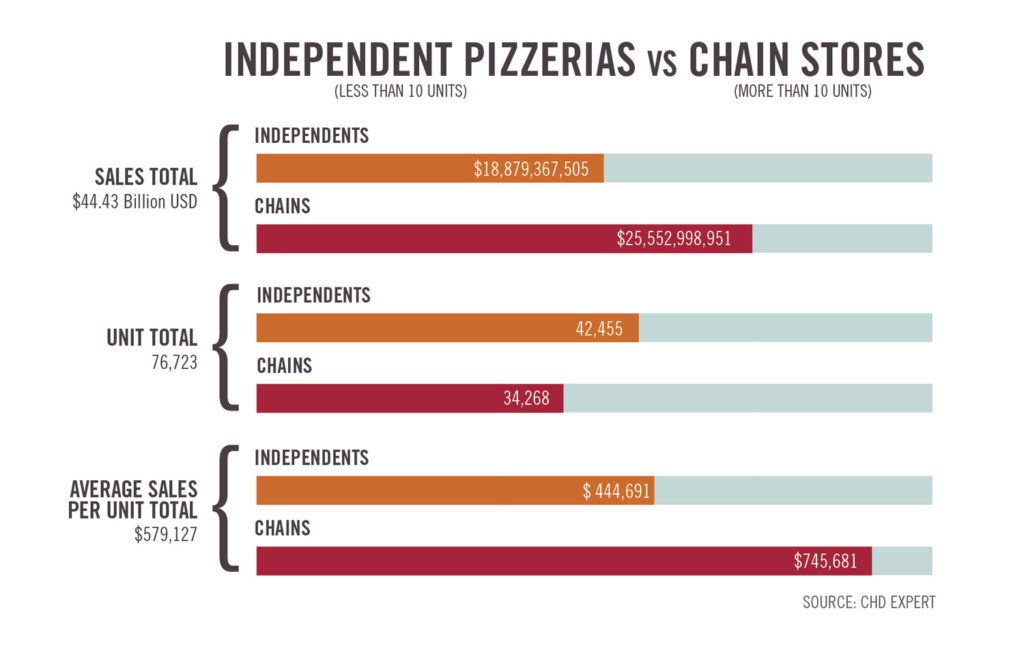
A New Approach to Categorizing Pizzerias
First, we’ve got some explaining to do about this year’s industry numbers. After working closely with research firms CHD Expert and Technomic, we’ve come up with some figures that don’t quite jibe with last year’s report. In the past, our data on pizza industry sales and store counts has varied because pizza itself has often been something of a nebulous restaurant category, floating between Quick Service (QSR), Full Service (FSR), Limited Service (LSR) and Fast-Casual. This year we’ve worked with CHD
Expert and Technomic to better define the overall pizza restaurant category for the purposes of this report. We include in our data both pizzerias traditionally categorized as LSRs as well as any other restaurants (such as FSRs) with the word “pizza” in their names (Example: The California Pizza Kitchen chain was left out of previous reports for a while because Technomic classifies it as a FSR, but, with our new classification method, we’ll include it in our reports from now on—it’s definitely a pizza restaurant in our book.) In short, if pizza features prominently on your menu, we’re counting you.
The upshot? This new, broader category has yielded substantially bigger numbers for overall pizza industry sales—plus a couple thousand additional stores—for the year ending September 30, 2016, compared to the previous year.
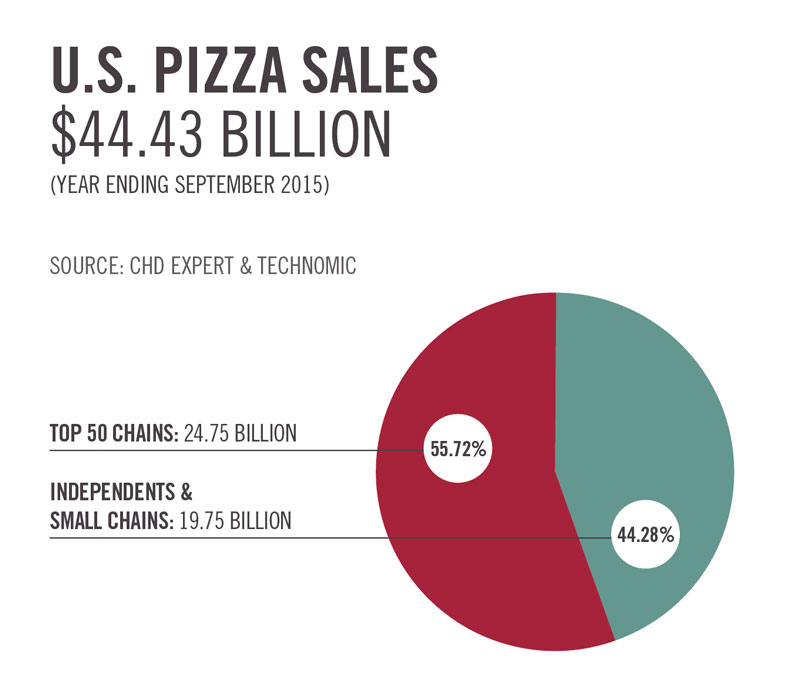
Top 50 Chains Show Gains
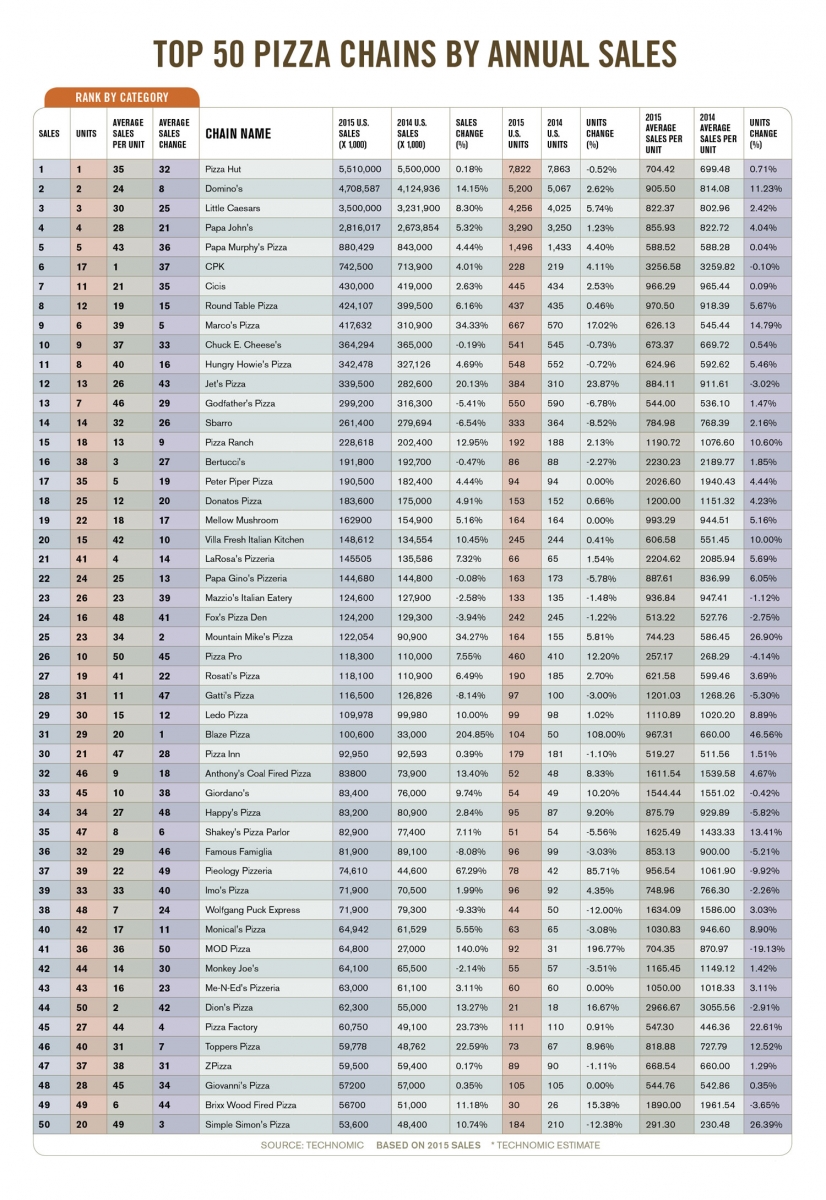 |
|
Click to view larger file. |
So let’s take a closer look at those numbers. According to CHD Expert, there were 76,723 pizza restaurants in operation as of the end of September 2016. A total of 5,377 new pizzerias opened their doors in the past year, while 6,066 closed down. But if you dig a little deeper, you find that independent pizza shops held their own compared to the chains in terms of opens and closes.
Independents opened 3,614 stores and closed 3,656 stores, for a net loss of only 42 units. Chains, meanwhile, opened 1,763 stores and closed 2,410, for a net loss of 647. The total impact on the industry was a net loss of only 689 stores—less than 1%.
But the chains, while closing more stores, still outsold the independents. Independents now comprise 55% of America’s pizza restaurants while bringing in only 42.5% of the sales. With a total of 42,455 units operating as of September 30, 2016, independents logged sales of $18,879,367,505 this year, while the chains raked in $25,552,998,951 with only 34,268 units, according to CHD Expert. Independents averaged $444,691 in sales per unit, compared to $745,681 per unit for the chains.
Combined, the independents and chains—again, we’re counting both LSRs and FSRs with “pizza” in their names—generated sales totaling $44,432,366,456,
according to CHD Expert.
To arrive at our estimate of overall industry sales growth from last year, we looked at a couple of different sources—Technomic and Euromonitor International. Technomic reports a 5% increase in pizzeria sales in 2016, while Euromonitor shows a 2.5% increase. By splitting the difference, we’ve arrived at an estimated increase of 3.75% in sales for the past year. All in all, these are encouraging numbers. A net loss of less than 1% of the country’s pizza stores, coupled with an increase in industry-wide sales of 3.75%, suggests the pizza industry has stabilized, at least for the time being.
At the risk of sounding like a broken record, we again attribute the pizza chains’ higher market share in large part to technology. Even the smaller chains have gotten wise to the power of online ordering, which also boosts ticket averages. As we’ll see later on in this year’s report, Domino’s and Pizza Hut have dedicated themselves to the proposition that convenience trumps quality these days, and smaller chains have no choice but to keep up if they want to stay competitive. The chains are also quick to experiment with new styles, unique toppings and trending flavor profiles. Independent operators who continue to underestimate the power of quick and easy ordering—paired with the enticement of flashy new menu items with bolder flavors—do so at their own peril.
Weird, Wild and Localized
Speaking of flashy new menu items, would you like a little kangaroo meat on your thin-crust? How about cactus or grasshoppers? If that sounds good to you, you may not be from around these parts. Although Americans have gotten pickier about the quality and flavor profile of our toppings, we still mostly stick with the tried-and-true: pork, chicken, maybe the occasional anchovy and, if you really want to get all fancy-pants, the odd truffle or two. For a real culinary adventure, you’ll have to hop on a jet to India or South Korea, where pizza makers, including at global chains like Pizza Hut and Domino’s, are reinventing the classic dish with local tastes in mind. “In nontraditional markets—those in which pizza is not traditionally a common offering—operators need to find ways to make pizza more appealing to consumers who are relatively unfamiliar with the format,” says Stephen Dutton, a consumer foodservice analyst with Euromonitor International. “Adopting local ingredients is one way to do this.”
In some cases, the experimentation gets a little wacky, but not always foreign to American palates. Pizza Hut Middle East has rolled out pizzas with cheeseburger sliders embedded in the crust and cone-shaped removable crusts stuffed with cream cheese. A Pizza Hut Singapore creation boasts a “lava crust” style, with Parmesan and cheddar cheeses oozing out of holes pocked throughout the crust. Things get a little stranger in Australia, where Pizza Hut last year launched a meat lovers pie on a crust stuffed with Vegemite, a thick, salty spread made from leftover brewers’ yeast extract.
“Pizza Hut has had a lot of success experimenting with their pizza offerings in international markets, because that’s what consumers often want and expect from these chains,” Dutton notes. The same goes for Domino’s, which encourages local sourcing of ingredients through its master franchise model and gives franchisees “a lot of localized control in terms of format type and product offering because they, as locals themselves, know what works best in their markets,” Dutton adds. “In India, one of the world’s most lucrative foodservice markets and one in which pizza is a largely unknown offering, Domino’s has launched market-specific formats—a sort of fast food-style format rather than Domino’s typical delivery/takeout format—and offers an array of pizzas you can’t find anywhere else, including a wide variety of vegetarian specialty pizzas and pizzas at varying spice levels, from spicy to extremely spicy.”
Overseas independents and smaller chains have been dabbling with homegrown ingredients, too. A restaurant in Sydney’s Australian Heritage Hotel tops pies with kangaroo, emu or crocodile meat. In South Korea, the up-and-coming Pizza Alvolo chain serves a crust made from Korean black rice and topping combos like sweet potato and bulgogi. Closer to home, Pixza, an independent store in Mexico City, builds its pies with dough made of blue corn, commonly used in tortillas and known for its healthy nutritional profile. “Pixza incorporates a wide variety of traditional Mexican toppings and ingredients, including cochinita pibil, mole, Jamaica flowers (hibiscus), nopales (a type of local cactus), and chayito, which are grasshoppers soaked in lemon juice,” Dutton says.
Keeping It Clean
Most Americans may not start gobbling down grasshoppers anytime soon, but, according to Technomic, we’re increasingly likely to try bold new flavors, such as pizzas inspired by Mexican, Asian and Caribbean cuisines, as well as innovative limited-time-only pies. Spicy flavors particularly resonate with today’s palates, as evidenced by the spicy red sauce option offered by Blaze Pizza, and Pieology Pizzeria’s LTO offerings: the Spicy Southwest (red enchilada sauce, mozzarella and cheddar cheeses, roasted red peppers, jalapeños, cilantro and chicken) and the Chicken Chile Verde (green enchilada sauce, mozzarella, roasted red peppers, diced mild green chilies, cilantro and chicken).
Beyond that, the watchwords for 2017 will be “authentic” and “clean,” both synonymous in the customer’s mind with “quality,” says Kelly Weikel, director of consumer insights for Technomic. “Authenticity is really big in terms of consumer demand overall,” she says. “In the pizza space, you have that natural association with Italian fare, so you have the opportunity to not just take authenticity from the quality approach but also from that approach of old-world tradition, recipes and sourcing of ingredients from Italy. You can go above and beyond authenticity in terms of quality to something that really connects it with a place and time.”
 |
|
&Pizza in Washington, D.C. stands out as a fast-casual restaurant brand with strong millennial appeal. Photos courtesy &pizza. |
Many independent pizzeria operators can lay claim to authenticity, especially if they have Italian roots or a history of community involvement. Going “clean” with your ingredients, however, can be costly. The term generally refers to fresh, organic, wholesome foods with few or no artificial ingredients, dyes and additives. According to Technomic, 58% of customers say they’d like restaurants to offer all-natural pizza. But locally sourced, organic ingredients can drive up food costs, and owners have to be careful not to buy more ingredients than they can use.
By their very nature, the megachains struggle with authenticity, but when it comes to “clean” ingredients, Pizza Hut and Papa John’s have been leading the way. Pizza Hut removed artificial flavors and colors from its core pizza line in 2015 and eliminated BHA and BHT additives from its meats this year. The company has vowed to get rid of preservatives in its cheese and human antibiotics in its chicken by the end of March and will strip out additional preservatives and additives by 2020.
Papa John’s has cleaned up its menu, too, at a reported cost of $100 million per year. Its grilled chicken toppings and chicken poppers now come from poultry raised without human or animal antibiotics and fed a vegetarian diet. The company says it has also gotten rid of 14 undesirable ingredients, including various artificial colors, flavor
enhancers, sweeteners, thickeners and preservatives. It even pulled the MSG from its ranch dressing. “It’s hard to remove some of these things and still get the flavor and functionality you want,” founder John Schnatter told Bloomberg. “We gave up flavor on the ranch dressing because I wanted to get the chemical out.”
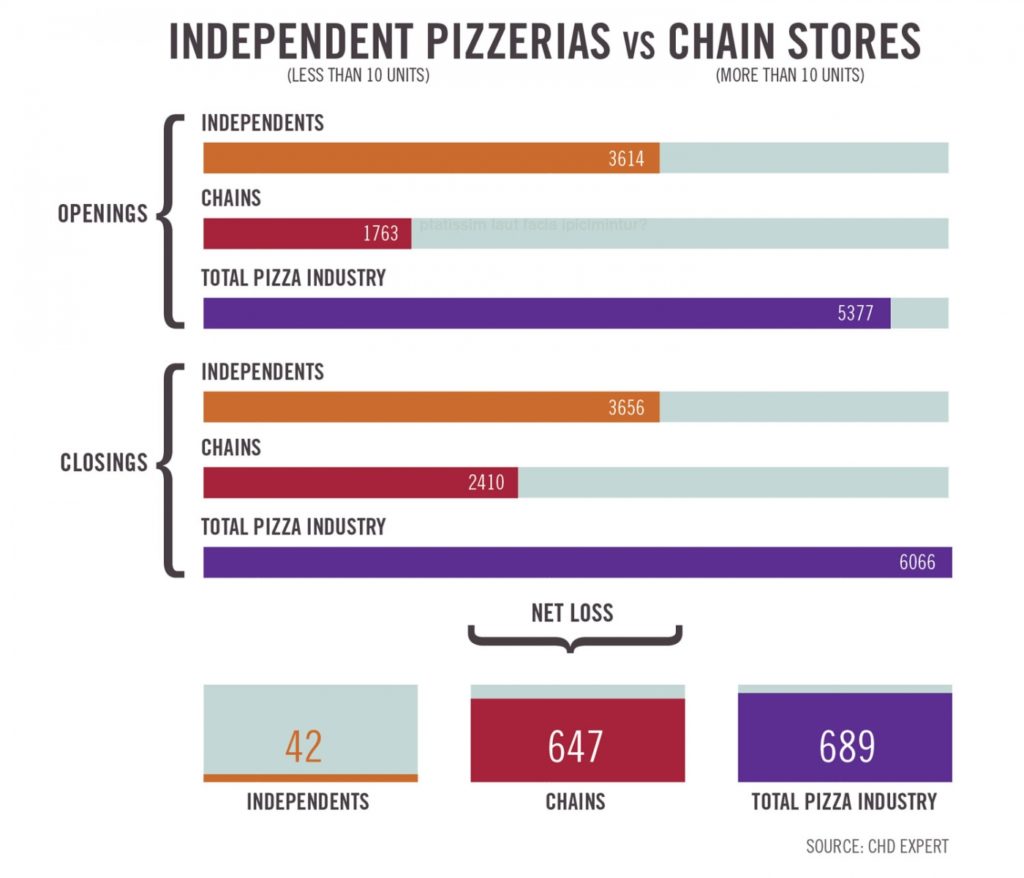
Third-Party Votes
The growing importance of online and mobile ordering cannot be overemphasized. Despite carrying their phones everywhere they go, many customers don’t want to actually talk on them—at least not to a harried pizzeria staffer who may put them on hold or botch the order. Online ordering will likely overtake phone orders by the end of the decade, and it fits hand-in-glove with delivery service.
As ordering online gets easier, experts say delivery will become a must-have for many restaurants—and not just pizzerias. A 2016 Morgan Stanley study found delivery is a $30 billion industry, but it has the potential to be worth more like $210 billion—the total amount currently spent on off-premise dining. Of that $30 billion figure, $11 billion in delivery orders are placed online, and nearly two-thirds of those online orders are for pizza. According to POS provider Toast’s Restaurant Technology in 2016: Dining Edition report, 57% of survey respondents now order from a restaurant’s website daily, weekly or monthly.
That means more requests for delivery, but many pizzerias already struggle to keep up with demand, which is why third-party providers—such as UberEats, Eat24, DoorDash and Caviar—have emerged as new power players. Online retailer Amazon even jumped into the game last year and delivers food in cities like New York, Dallas, Seattle, San Francisco, Los Angeles, Chicago and Baltimore. Many of these companies field the online orders for restaurants and even handle all or some of the delivery—for a substantial fee, of course (up to 30% of the order).
Elsewhere in this month’s PMQ, Rick Drury, owner of Precinct Pizza in Tampa, Florida, describes his recent foray into third-party delivery (“The Third-Party Wave, Part 1,” Page 64). He says pizzerias can save money on drivers and related expenses, but they risk losing that all-important personal connection with their customers. And since third-party providers act independently of the pizza restaurant, there’s no way to control how the drivers present themselves to customers. A survey by Technomic, On Demand Delivery: Disrupting the Future of Foodservice, echoes Drury’s concerns; it found that 76% of consumers will hold the restaurant at least partially responsible for errors made by a third-party delivery service.
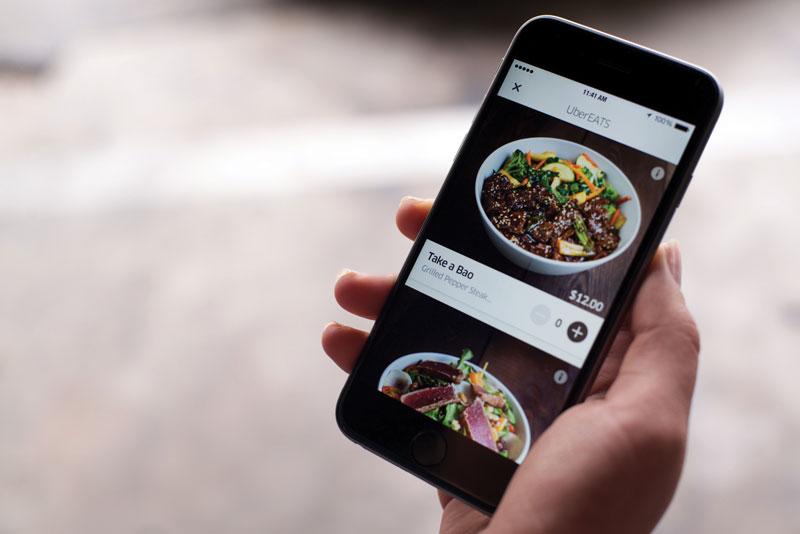 |
|
Third-party companies like UberEATS have emerged to help meet rising demand for online ordering and delivery. Photo courtesy uberEATS. |
Doubling Down On Easy
The rising demand for online ordering and delivery isn’t exactly shocking news to the major chains. Greg Creed of Yum! Brands told investors this year that “easy beats better” is the company’s new mantra, especially for Pizza Hut. Creed found inspiration in an unexpected source: the ride-sharing service Uber. “If you think about the Uber experience, it’s easy to order, it’s easy to pay, and then it’s very easy to track,” he told investors earlier this year, adding that it’s time to “double down on easy.” With that in mind, Pizza Hut has renewed its focus on faster delivery and added a loyalty program tied to its mobile app. But it will have a hard time catching up with its rival, Domino’s. Although Domino’s trails Pizza Hut in total number of stores, the delivery giant takes a back seat to no one in ease of ordering. Don’t look to NASA for a breakthrough in teleportation—if there’s a way to beam a meat lovers pie into your living room, Domino’s is on track to figure it out first.
Domino’s multiplatform Anyware campaign lets customers order pizza from almost anywhere—with a tap on their smart watch, by voice in their snazzy Ford Taurus, or with a click of their remote in the middle of Game of Thrones. Once they go online and set up a “Pizza Profile” (including name, address and credit card number) with their favorite “Easy Order” (say, a medium thin-crust with pepperoni and sausage), customers can text or tweet a pizza emoji, shoot off an order via Facebook Messenger or bark a command to their wireless, voice-controlled Amazon Echo, and pizza’s on the way. Does that still sound like too much work? The company’s Zero-Click app caters to the truly indolent, placing an “Easy Order” automatically when it’s opened—no clicks required, although there’s a 10-second countdown in case the customer changes his mind.
It’s no wonder many industry observers now refer to Domino’s not as a pizza chain but as a tech company. In 2014, Domino’s rolled out its own version of Apple’s Siri, a smartphone-dwelling personal assistant ready to tend to the user’s every pizza need, and has been tinkering with delivery robots in Australia and drone delivery in New Zealand. Meanwhile, the company’s flashy DXP “super-delivery” car, tricked out with a built-in warming oven and space for 80 pizzas, makes every trip a joyride for drivers at dozens of U.S. locations.
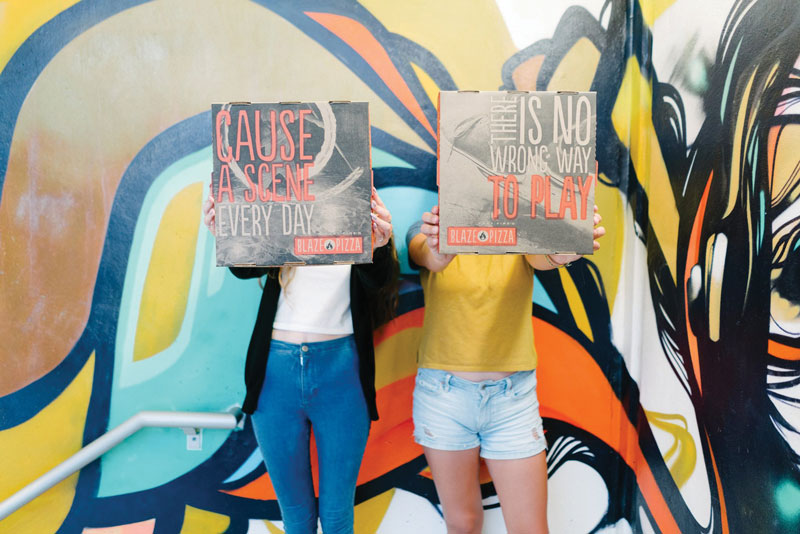 |
|
The fast-casual Blaze Pizza chain emerged as the No. 1 fastest-growing restaurant chain in the U.S. this year. Photo courtesy Blaze Pizza. |
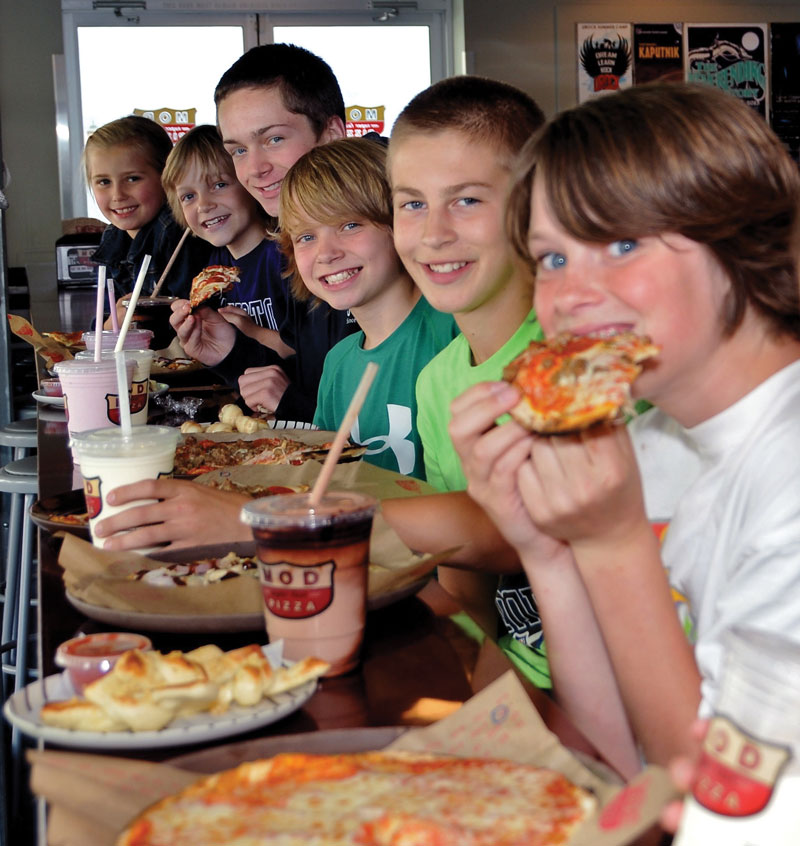 |
|
After launching in 2008, MOD Pizza has already become one of the five fastest-growing restaurant brands in the country. Photo courtesy Mod Pizza. |
The Fast-Casual Phenomenon
If all that digital wizardry makes you want to write an angry letter to the editor on your Smith-Corona typewriter, just remember that millennials—a segment of young consumers now aged about 19 to 34—use these technologies to buy more pizza. A LendEDU study of 500,000 transactions on Venmo, a fast-growing app that’s essentially Paypal for the 20-something crowd, found pizza was the most common purchase by millennials (also high on the list were tequila and strippers—we never said millennials were angels).
As PMQ reported in last year’s report, millennials have become a force to be reckoned with, and their demand for customizable meals has also fueled the fast-casual trend, which continued unabated last year, according to Technomic’s 2016 Top 500 Chain Restaurant Report. The fast-casual segment nearly doubled the growth rate of any other dining segment in 2015, achieving 11.4% sales growth. Blaze Pizza emerged as the fastest-growing restaurant chain of 2015, with year-over-year sales up by 205%. Two other fast-casual pizza companies were among the five fastest-growing restaurant brands: MOD Pizza’s sales climbed by 182%, and Pieology Pizzeria posted a 67% gain.
Keep in mind that Blaze Pizza opened its first location in 2012, while Pieology launched in 2011, and MOD Pizza started in 2008. With growth like that, maybe we should stop labeling fast-casual a trend and start calling it a phenomenon.
One Last Victory in Nutritional Labeling
Under FDA rules scheduled to take effect May 5, 2017, restaurant chains with 20 or more locations will have to provide calorie counts for all regular menu items, along with a statement about suggested daily caloric intake. More nutritional data—covering total fat, trans fat, saturated fat and carbs, to name a few—must be disclosed in writing upon customer request.
Earlier versions of the rules, which counted a whole pizza as a single serving, alarmed the pizza industry. After some pushback, revised guidelines allowed most pizzerias to list calories and related info by the slice (as long as they state how many slices each whole pizza contains) and to list a range of calories for build-your-own pies with various possible combinations of toppings. But the rules presented one last hurdle for the pizza industry, specifically for pizzerias that serve party-style or square-cut pies. Round pizzas yield roughly uniform slices—each with about the same amount of crust, sauce and toppings—making it easier to come up with a single calorie count per slice. But nonround pies may yield slices in various sizes and inside pieces with no corners, and deriving a single calorie count for those pieces would have been much more difficult. Hence, pizzerias that serve nonround pizzas would still have been required to declare a calorie total for the whole pizza, a deceptively larger number, instead of by the slice.
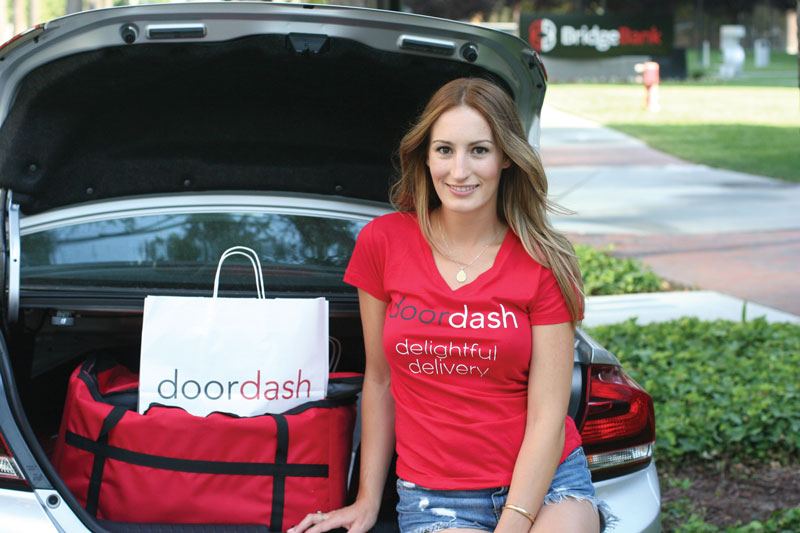 |
|
DoorDash has become a player in food delivery. Photo courtesy DoorDash. |
Marla Topliff, chair of the NRA’s Pizzeria Industry Council and president of the Rosati’s Pizza chain (which serves party-style pies), enlisted foodservice nutrition consultant Betsy Craig, founder and CEO of MenuTrinfo, to change the FDA’s mind. “We were originally told the only option these pizzerias had was to label the calories for the full pizza, but we fought to show the FDA how this could put them at a disadvantage,” Craig said. “The calories for an entire large pizza would appear astronomical, especially compared to their competition, which may label their calories by the traditional triangular slice.” The FDA agreed to let pizzerias with nonround pies list per-slice data based on an average slice size, as long as they don’t under-declare numbers for calories, fat and saturated fat or over-declare on nutrients like fiber and vitamins. “Having the calories provided per slice of pizza, as opposed to an entire pie, will not only enable guests to better understand the information; it will also allow our clients more flexibility in their labeling,” Craig said.
Smaller chains and single units will be exempt from the new rules, but should they offer nutritional data anyway? “I think they should,” Weikel says. “Consumers feel strongly entitled to know what they’re eating—how many calories, how much fat, etc. I think that information needs to be made available to the consumer. It doesn’t necessarily have to be front and center—you could just put it deeper into your app or your website.” The numbers probably won’t surprise customers anyway, and they won’t stop eating your pizza based on nutritional data. “Pizza is still an indulgence,” Weikel says.
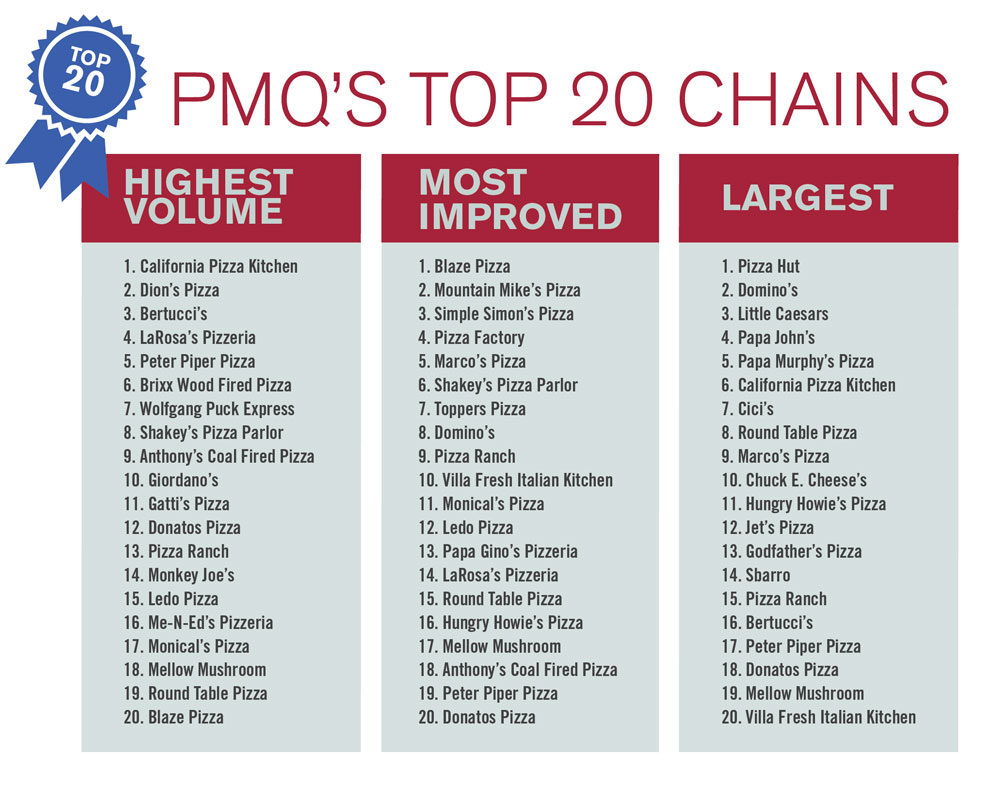
How to Compete in 2017
1 Clean up your act.
Millennials want natural ingredients and “responsibly raised” meats without any added hormones and antibiotics. Natural, unprocessed, sustainable and locally grown ingredients are more important than “low-fat” and “low-carb” to many consumers, especially millennials and Generation X.
2 Offer nutritional data.
Once the larger chains start providing this info as required by law, health-conscious customers will come to expect transparency from smaller pizzerias, too. According to the National Restaurant Association, 70% of customers order more healthful options at restaurants today than they did 10 years ago. You don’t have to put nutritional data front and center on your menu, but make it available on your website or in your app.
3 Get creative in the kitchen.
Create new specialty pizzas and LTOs featuring locally grown, in-season toppings, and explore new flavor profiles and ingredients, such as chorizo, chipotle or
Jamaican jerk chicken. To boost your lunch business, offer lighter, personal-size pizzas or create a brunch pizza for the weekend crowd, Technomic recommends.
4 Take the online ordering plunge.
Talk to your POS company about the options available to you. If they can’t help, third-party providers now abound, and you can negotiate with them on fees and commissions.
5 Cash in on the demand for delivery.
If you’ve never offered delivery before, this is the time to give it a second look. You don’t necessarily need a team of drivers; third-party aggregators like DoorDash and UberEats will get your pizza into more living rooms if you’re willing to share a piece of every sale.
6 Reward your loyal customers.
The major chains are leveraging tech-based rewards programs to foster loyalty and acquire crucial data about their customers. Don’t let them get ahead of you. Set up a system that your customers can use online and offline, make signup a snap, track spending habits, and tailor your rewards to users.




